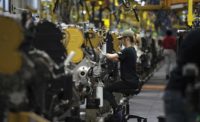Caterpillar Reports Strong Third Quarter, But Tariff Worries Grow in Market
At a time when growing concerns over tariffs and shaky investments, Caterpillar posted strong gains in the third quarter of 2018. But market analysts are seeking clearer answers on how the company may absorb a rise in material costs.
The Peoria, Ill.-based equipment manufacturer on Oct. 23 posted sales and revenue of $13.5 billion, up 18% over the third quarter of last year. But historically strong results were not enough to stave off concerns about rising material costs and market uncertainty, which drove a selloff of Cat stock in the following days. Shares (NYSE: CAT) were trading at $114.72 at midday Oct. 30, well below the 52-week high of $173.24 recorded on Jan. 16.
Despite an upbeat report on sales and revenue, the Cat Q3 earnings report was overshadowed by the expected impact of tariffs on imported steel and aluminum announced earlier this year. Cat put a price increase into its equipment soon after the announced surcharges, and CEO Jim Umpleby remained upbeat about the impact during the Q3 earnings call. “We previously stated that in the last six months of the year we would have cost headwinds of $100 million to $200 million, we are going to be on the lower end of that range, we believe,” he told analysts and journalists during the briefing.
The issue of planned tariffs by the U.S. Dept. of Commerce on imported steel and aluminum, as well as machine components used in heavy equipment has been an ongoing concern for the U.S. equipment industry. While some companies such as Cat have already announced surcharges, existing supply chain issues have prevented the companies from buying materials and components in large volume in advance.
When asked about the possibility of Cat or other manufacturers pre-buying steel and other materials that may soon to be subject to higher tariffs, Umpleby said that wasn’t a realistic strategy. “We haven’t seen a big pre-buy, but we’ve had some constraints as we’ve been on managed distribution,” he explained, citing issues many equipment suppliers have had in meeting high demand in 2018. As to the question of whether an expected jump to 25% tariffs on steel would have a deeper effect, he says “we don’t expect a major impact as we were already hit with the earlier tariffs, so we don’t think a later change will have a big impact on us. It was already baked in for us.”
But despite the tariff troubles, Cat is in good shape to weather a rough market, says Umpleby. The company reported having $8 billion of enterprise cash on hand, even after accounting for $500 million in dividends and $750 million in stock buybacks this last quarter.
Yet the signs of rising production costs are already being seen. In addition to the cost increase announced earlier this year, Cat has already told its dealers to expect a 1% to 4% price increase to take effect in January, 2019. But despite this, Umpleby sees positive signs for next year. “We are working our way through supply constraints, and we feel good about the environment for prices moving forward. We expect our business to continue to improve in 2019.“
Analysts noted the tariff costs may impact prices, but found the company's fundamentals to be otherwise strong for next year. "While Cat did not guide specifically for 2019, commentary implied the company sees no evidence of markets weakening and instead sees very good growth prospects across multiple markets heading into next year,” said Credit Suisse analyst Jamie Cook in a note to investors following the earnings report. While Cat’s stock price has declined in recent weeks as part of a general selloff of major stocks in the market, she says that the company “is set up fairly well for FY ’19, both in terms of fundamentals and capital deployment.”


